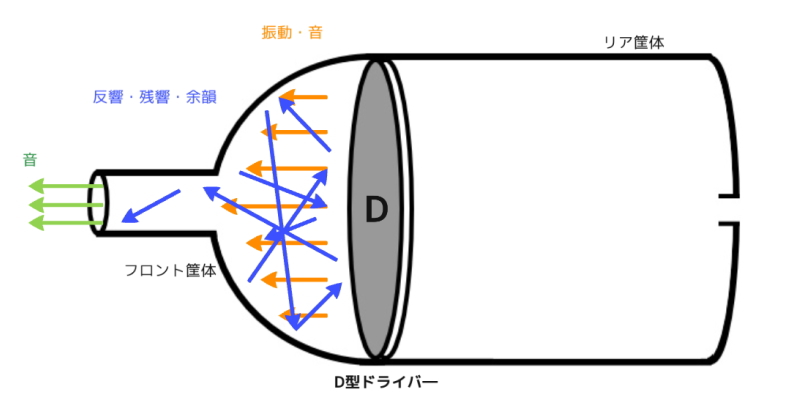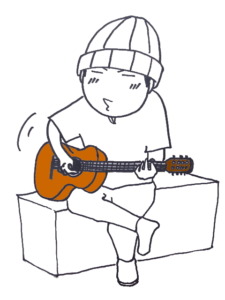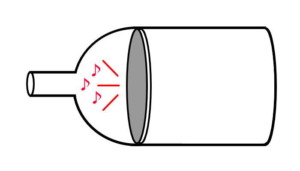It’s been a bit busy and there has been a bit of a pause, but let’s get on with the project of making 634EARS the best earphones.
In this project, we will be talking a lot about materials of diaphragms, materials of chassis, design and tuning, and other deep topics, especially about materials.
So, first of all, in order to ensure the understanding of this project, I will explain the premise of the project, “the source of sound and the role of each” in this article.
If you think about the relationship between materials and sound without a clear understanding of this point, you may miss the point entirely, and in fact, I feel that this is often the case.
On the other hand, if you understand this point accurately, you will be able to better understand the selection of materials, design, drivers, and wood.
It is a bit long, but please read it when you have time.
It’s no surprise this time, but it’s one for the preservation books!
1) This is common when talking about materials.
2) Sound comes from the D-type driver.
3) The D-type driver divides the space into front and rear.
4) Front and Rear have different roles.
5) Let’s think of a musical instrument.
6) What about earphones?
7) You cannot hear the “sound” of the rear enclosure.
8) We cannot talk about the characteristics of materials without distinguishing between front and rear.
*)*This topic assumes dynamic driver earphones.
1) This is common when talking about materials.
When we talk about materials, we often hear things like “metal has a __ sound…”, “wood is warm and soft…”, “resin is…”, “titanium is…”, “brass is…”, etc. What should never be mistaken is “Which part of the earphone is the material used for? What should never be mistaken is “Which part of the earphone is the material used for?
Without knowing this, “metal is sharp” or “wood is soft” can only be said under the mistaken impression.
In reality, however, it is often ignored where the “material” is used. In some cases, not only the material used for the chassis, but also the material used for the diaphragm are all lumped together and explained together.
2) Sound comes from the D-type driver.
Most importantly, the sound itself is emitted from the D-type driver. More strictly speaking, the diaphragm of the D-type driver moves and emits sound.
Of course you mean the sound is coming from the driver diaphragm!
You might think so, but it’s actually super important! Read on after this.
When the dynamic driver of an earphone is connected and operated by itself, sound is emitted only from the front of the driver.
The diaphragm moves, so technically it is vibrating both forward and backward, but what we actually hear as “sound” is the sound coming from the direction the diaphragm is facing.

In the case of canal-type earphones, the sound comes out of the tip of the nozzle of the housing and we listen to it.
3) The D-type driver divides the space into front and rear
Now that we know that the sound is coming from the driver in a forward direction, let’s look at the role of the enclosure.
The enclosure of a D-type driver is divided into several parts depending on the earphone, but can be broadly classified into two categories: “in front of” or “rear” the driver.
The “front” and “rear” spaces are basically separated by the D-type driver.
You also have earphone enclosures with a one-piece construction without front and rear borders, right?
It is true that some enclosures are like that, but even if they are not separated as parts, the interior is divided into front and rear spaces with the D-type driver as the boundary.
In the case of the 634EARS.
LOAK, for example, the front of the dynamic driver is made of stainless steel or titanium, and the rear is made of stainless steel and wood.
In the case of MIROAK, the metal parts are connected in a one-piece shape, but the front of the driver is aluminum, and the rear is aluminum and wood (or various metals).

In some cases, the front and rear drivers are strictly connected by a tube inside the driver, or there is a path leading from the front of the driver to the rear, and in some cases, the diaphragm is made of a material that is slightly transparent to begin with, so they are roughly “separate spaces” or “separate rooms,” although this is not entirely true.
4) Front and Rear have different roles.
So what is the difference between the front and rear of a D-type driver?
《Front》.
In front of the driver, “the sound from the D-type driver is emitted as sound from the tip of the nozzle while reverberating and so on. This is the space and sound conductor for this purpose.

The point here is “the sound emitted from the D-type driver.
The “sound emitted” changes depending on the shape, material, and thickness of the enclosure and comes out as sound from the tip of the nozzle. To put it more simply, we can say “the sound after it is generated.
The key point is “the sound after it is generated from the diaphragm.
《Behind》.
Behind the driver, “the movement of the D-type driver changes (is affected) by the material, thickness, shape, and size of the enclosure behind it.
The point here is “the movement of the D-type driver changes (is affected by)”.

The front of the driver changes the “sound after it is generated” from the D-type driver, whereas the rear of the driver affects the movement of the D-type driver. That is, it affects the “sound generated from the D-type driver”.
The key point is that it affects “the movement of the diaphragm (the sound generated).”
And what we are hearing is “the sound after it is generated by the D-type driver).
Please remember this absolutely. It is very important.
5) Let’s think of a musical instrument.
When discussing audio equipment such as earphones and headphones, the materials of “musical instruments” are often used as references.
However, musical instruments also have completely different mechanisms for producing sound, so if you make a mistake in what you refer to, you will miss the point entirely.
There are various types of musical instruments, each of which plays a different role, so let’s take a look at some simple examples and categorize them into broad categories.
《The vibrating body that is the source of sound (acoustics).》
This is, as the name implies, anything that emits vibrations that are the source of sound.
For example, cymbals, drum heads, triangles, xylophones, guitar and violin strings, etc.
Without these vibrations, sound cannot occur.
《To vibrate a vibrating body》
Vibrating bodies also do not vibrate if nothing is done to them, so we need something to make them vibrate.
For example, a bachi to strike a drum or xylophone, a bow to scrape the strings of a violin, a guitar pick or fingernail, lips or palms of the hands, or other parts of the body directly for some instruments, and strictly speaking, the hands and feet of the person or persons using these objects are also included.
《The site where vibrations are amplified and radiated as sound》
This is the part of a vibrating body that radiates the vibrations produced by the vibrating body into the air as sound.
For example, the soundboard of a piano or the body of a guitar.

In addition, there are various other parts, such as piano pieces and guitar bridges for “transmitting and expanding the vibration of the vibrating body,” and support parts for “supporting the vibrating body.
Various instruments, such as violins, guitars, pianos, and drums, are made by placing them in the right places to form a single instrument.
For example, the source of sound in a classical guitar is the strings, which are moved by a pick or hand plucking, and the vibration of the strings is transmitted from the bridge to the body, where it is amplified and heard as sound.
Each part has its own role and what is required of it as a material is naturally different.
6) What about earphones?
So what if we apply it to earphones?
In the case of D-type drivers, the source of sound is the driver and diaphragm.
There are electric signals, coils, and magnets to vibrate the diaphragm, but I think it is safe to assume that the source is simply the diaphragm.

The source moves due to electrical signals and magnetic forces generated by the signals, but the material, shape, thickness, and space of the rear housing affect the degree of movement (degree).
The sound (vibration) is radiated from the driver and reflected inside the enclosure in front of the driver, and is heard as sound from the tip of the nozzle.
Each of these parts plays a completely different role just like a musical instrument, and of course, what is required of them is also different.
The diaphragm is the source of sound, the front enclosure transmits and radiates the sound, and the rear enclosure influences the sound of the source.
The diaphragm should be stiff, flexible, and have minimal internal loss. Some parts of the enclosure must suppress vibrations from the D-type driver, while other parts must transmit vibrations without loss.
The rear enclosure is also related to the tuning of the driver, and in some cases it is better to have a stiffer and heavier enclosure, in other cases a lighter and stiffer enclosure, and in other cases a more elastic yet lighter enclosure.
However, in reality, I feel that people often think that “metal = … sound” and “wood = … sound” without knowing which part of the material is used and in what role.
If we compare it to the classical guitar, the diaphragm (driver) is the strings, and the front housing is the bridge and body.
The rear housing is the hand or arm of the person playing the guitar, including the pick and fingernail.
Each of them plays a different role and requires different things, but it is also difficult to say “metal = … sound” and “wood = … sound,” or “brass = … sound” and “rosewood = … sound” in the same sentence.
7) You cannot hear the “sound” of the rear enclosure.
From what has been said so far, the rear enclosure affects the “diaphragm movement” of the driver, which in turn affects (changes) the “sound generated” from that diaphragm.
In other words, there is no sound being emitted inside the rear enclosure and it is not being heard directly from anywhere.
Strictly speaking, the diaphragm material is not a material that completely shuts off the front and rear sides, so there may be a slight possibility that sound from the rear space comes to the front, but basically, even if sound is emitted in the rear enclosure, it is not heard from the tip of the nozzle in the front enclosure.
The rear enclosure “affects” the diaphragm of the D-type driver, not what sounds and is heard inside the rear enclosure.
This is a point that may be misunderstood by a great many people.
If you strike metal, you get a hard, cool, high-pitched “Kahn! If you hit metal, you will hear a hard, cool, high-pitched sound, and if you hit wood, you will hear a slightly softer, warmer sound with a “clang” or “thump,” and if you hit resin, you will hear a “thump,” “thump,” “thump,” “thump,” or “thump. In the case of earphones, however, we are talking about the “diaphragm material.

In reality, however, it is very common to speak of this kind of material image as being applied to all enclosure materials and diaphragm materials. This is not the case at all, and we must be careful.
It is the diaphragm of the D-type driver that produces the sound, which passes through the front enclosure in front of the driver and is heard from the tip of the nozzle.
Very important point! The “sound” inside the rear enclosure is not audible.
You can actually choose wood or metal for the rear enclosure in 634EARS, but we very often get questions about the image of the material we just tapped.
Since you cannot hear the “sound” inside the rear enclosure, what you need to consider when choosing the material for the rear enclosure is how the diaphragm will be moved.
8) We cannot talk about the characteristics of materials without distinguishing between front and rear.
The diaphragm, front enclosure (which can be further subdivided into nozzle, cup, and driver installation parts), and rear enclosure (which can be further subdivided into shell and back parts) each have different roles and are required different things.
It is completely wrong to talk about them in terms of the image you get when you tap them, or in terms of the image of the sound of the material used only for a specific instrument.
How did we end up with such a sober image?
Perhaps it is because it is difficult to accurately convey this information through catchphrases, claims, and short explanations, since it must be understood one at a time, step by step.
So I think it was easier to convey only the “result” as the sound of the material in the product, and this may have led to strange misunderstandings as things piled up.
The source of sound is the diaphragm of the D-type driver. From there we hear sound through the front enclosure. This is a simple but important point to remember.
If you understand what I have just explained, what I will explain in the future will be very easy to understand because there are many characteristics of each material.
After this, we will share the process of making the best 634EARS earphones by selecting the best materials for the front, rear, diaphragm, and even the smallest details, so please take your time and enjoy the contents.
【To summarize】
The sound is generated from the diaphragm of the D-type driver.
The housing of the earphone is divided into front and rear spaces with the D-type driver as the boundary, each having a different role.
The “sound” in the rear enclosure cannot be heard.
The source of sound is the diaphragm of the D-type driver, from which we hear the sound coming from the tip of the nozzle through the front enclosure.

